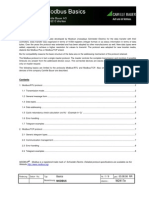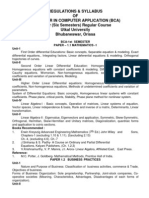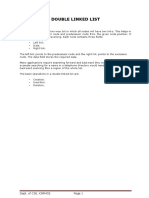Using MODBUS
Using MODBUS
Uploaded by
Daniel FerrariCopyright:
Available Formats
Using MODBUS
Using MODBUS
Uploaded by
Daniel FerrariCopyright
Available Formats
Share this document
Did you find this document useful?
Is this content inappropriate?
Copyright:
Available Formats
Using MODBUS
Using MODBUS
Uploaded by
Daniel FerrariCopyright:
Available Formats
Using the Modbus Protocol in Metretek Correctors
Technical Documentation
AE5000/6000 Modbus Protocol Driver - Technical Documentation
Revision 1.0
MODBUS PROCESS DESCRIPTION
The Modbus process provides configuration capabilities for the Modbus protocol driver. Modbus driver options
and register assignments are supported through the process.
ITEM DESCRIPTION FOR MODBUS PROCESS
( Section 2 )
Item 1, 02-01 Modbus Address
This parameter configures the Modbus address for which the RTU will communicate with. Valid numbers are 1 to
247.
Item 2, 02-02 Mode: 0=RTU 1=ASCII
The mode parameter configures the Modbus communication mode. A value of 0.0 selects Modbus-RTU and a
value of 1.0 selects Modbus-ASCII.
Item 3, 02-03 Active 0=no, 1= yes
This parameter enables/disables the Modbus communications driver. If disabled (0.0) then the eagle protocol, or
other activated protocols will function. If enabled (1.0) then the Modbus protocol will function. When enabled, the
protocol will be supported over the current communication link (direct, phone, radio, & etc.). The only exception is
when the RS232 alarm pin is grounded. In this case, the RTU will always communicate using the Eagle protocol.
Item 4, 02-04 Communications Port
This parameter allows selection of the serial port to be used by the Modbus driver. This will provide for extra serial
ports to use the protocol. Currently, this parameter is not used.
Item 5, 02-05 Single Int Reg Start
The starting register number for 16 bit integers is specified here. The default value is 3000. This value is normally
used with all systems.
Item 6, 02-06 Single Int Reg End
The ending register number for 16 bit integers is specified here. The default value is 4999. This value is normally
used with all systems.
Item 7, 02-07 Double Int Reg Start
The starting register number for 32 bit integers is specified here. The default value is 5000. This value is normally
used with all systems.
Item 8, 02-08 Double Int Reg End
The ending register number for 32 bit integers is specified here. The default value is 6999. This value is normally
used with all systems.
Item 9, 02-09 Floating Pnt Reg Start
The starting register number for 32 bit IEEE floating point numbers is specified here. The default value is 7000.
This value is normally used with all systems.
Item 10, 02-10 Floating Pnt Reg End
The ending register number for 32 bit IEEE floating point numbers is specified here. The default value is 65535.
This value is normally used with all systems.
Using MODBUS Page : 1
Using the Modbus Protocol in Metretek Correctors
Technical Documentation
Item 11, 02-11 Register/Index Offset
This item is intended to allow adjustments to support different variations of the Modbus protocol. It is currently not
used however.
Items 12 to 16, 02-12 to 02-16 Spare
These are spare items for future use.
( Section 3 )
Item 1, 03-01 Process Status
This item is not used by the Modbus process except in the standard manner to indicate that a process parameter was
edited.
( Section 4 )
Items 1 to 16, 04-01 to 04-16 Register.Config
These items are used in conjunction with the section 5 to specify the Modbus register/ Eagle PP-SS-II conversion
mappings. In section 4, the register number is specified in the integer portion of the value. The Config (fractional
portion) value may have different meanings depending on what type of register is being defined. The following
describes the Config value usage for each register type:
Boolean Register: For a Boolean register (normally address 1001 - 2999) the Config parameter is used to defined
the bit position and logic level for the value located at the PP-SS-II:
Config = .BBL
0 = Modbus function will use same logic as bit. 1 = logic is inverted.
Specifies the bit number. Valid bit numbers are 1 - 16.
The Config parameter is currently unused with other data types.
( Section 5 )
Items 1 to 16, 05-01 to 05-16 PPSSII
These items correspond to the register numbers in section 4 to specify the Modbus register mapping.
( Section 6 )
Items 1 to 16, 06-01 to 06-16 Register.Config
These items are used in conjunction with section 7 to specify the Modbus register mapping. See the Section 4
description for more details.
( Section 7 )
Items 1 to 16, 07-01 to 07-16 PPSSII
These items correspond to the register numbers in section 6 to specify the Modbus register mapping.
( Section 8 )
Items 1 to 16, 08-01 to 08-16 HistProc.Column
These items are specified in conjunction with the values in section 7 and 8 to provide support for history polling
over the Modbus protocol. The HistProc (integer) portion of the value specifies the process number of the history
process to associate with the Modbus Register number. The Column (fractional) portion of the value specifies the
column of the history process to be used.
Using MODBUS Page : 2
Using the Modbus Protocol in Metretek Correctors
Technical Documentation
PPSSII TO MODBUS REGISTER ADDRESS CONVERSION
There are two methods of conversion between the PPSSII and Modbus register addresses. In the first method, a
simple calculation is used to convert between the two address formats:
Modbus Reg = 20000 + [(PP-1)*256 + (SS-1)*16 + (II-1)]
therefore (using integer arithmetic )
PP = ((Modbus Reg - 20000 ) / 256) + 1
SS = ((Modbus Reg - 20000) mod 256) / 16) + 1
II = (((Modbus Reg - 20000) mod 256) mod 16) + 1
In the second method, the process database specifies the register mappings.
MODBUS FUNCTION CODES SUPPORTED
DESCRIPTION FUNICTION NUMBER
Read Boolean 1
Read Numeric Register 3
Set Single Boolean 5
Set Single Numeric 6
Set Multiple Boolean 15
Set Multiple Numeric 16
Enable Modbus
The native protocol of the 5000/6000 series instruments (Hex ASCII), has a
special message (type 34) that is used to temporarily enable the corrector’s
Modbus protocol driver. This message is as follows:
[02h]0000000022000000[03h]0
where all digits are ASCII except the start [02h] and end [03h] frame characters
which are binary.
The message causes the corrector to scan its database looking for a Modbus protocol process. The corrector will
enable the first Modbus process that it locates, and it will then remain in “Modbus” protocol mode until a
programmed interval passes without receiving a valid Modbus message (typically 20 seconds), at which time it will
revert back to it’s native protocol mode of Hex-ASCII.
Using MODBUS Page : 3
You might also like
- ARM Microcontrollers Programming for Embedded SystemsFrom EverandARM Microcontrollers Programming for Embedded SystemsRating: 5 out of 5 stars5/5 (1)
- ModbusDocument35 pagesModbusyoussef mimmis100% (1)
- 9300 Series Modbus RegistersDocument76 pages9300 Series Modbus RegistersFigura3xNo ratings yet
- Champion Compressors Modbus RTU Manual: Aircon L1 Compressor Controller Enercon Sequencer Controller & AccessoriesDocument45 pagesChampion Compressors Modbus RTU Manual: Aircon L1 Compressor Controller Enercon Sequencer Controller & Accessoriessudirmanpriyo100% (2)
- How To Segregate The Access To MIGO Transaction Like All The Other SAP TransactionsDocument5 pagesHow To Segregate The Access To MIGO Transaction Like All The Other SAP Transactionsolivier larocheNo ratings yet
- ModbusDocument16 pagesModbusagus wijanarko100% (2)
- Using FieldServers in ModbusTCP ApplicationsDocument26 pagesUsing FieldServers in ModbusTCP Applicationsrpandit075698No ratings yet
- What Is Modbus and How Does It WorkDocument59 pagesWhat Is Modbus and How Does It Workhasbi fadliNo ratings yet
- Additional Setup Instructions For Modbus: RTU, ASCII, TCP, Omni & EnronDocument10 pagesAdditional Setup Instructions For Modbus: RTU, ASCII, TCP, Omni & EnronAdriana escobar hernandezNo ratings yet
- MODBUS Communication With S7-200Document6 pagesMODBUS Communication With S7-200Vinh Bui100% (1)
- Communication Methods For SASDocument10 pagesCommunication Methods For SASRamesh KumarNo ratings yet
- Modbus RTU Page Refresh 2019 v3Document6 pagesModbus RTU Page Refresh 2019 v3Evance OgutuNo ratings yet
- Using MODBUS For Process Control and AutomationDocument1 pageUsing MODBUS For Process Control and AutomationazrinoordinNo ratings yet
- DRS202M Modbus Register MapDocument15 pagesDRS202M Modbus Register MapSocaciu VioricaNo ratings yet
- Communication Methods (Protocols, Format & Language) For The Substation Automation & Control by MUHAMMAD UZAIR (Project Report of Course 586 B)Document10 pagesCommunication Methods (Protocols, Format & Language) For The Substation Automation & Control by MUHAMMAD UZAIR (Project Report of Course 586 B)Nima MahmoudpourNo ratings yet
- Modbus English Document v7 20180718_1645Document38 pagesModbus English Document v7 20180718_1645trgyadaNo ratings yet
- Manual X Stream Enhanced Gas Analyzer Series Modbus Manual en 5124876Document96 pagesManual X Stream Enhanced Gas Analyzer Series Modbus Manual en 5124876Luis Miguel EstradaNo ratings yet
- Anr-Lan: Instruction ManualDocument36 pagesAnr-Lan: Instruction ManualSamuel E. MarinaoNo ratings yet
- Modbus Protocol Overview With Examples2Document2 pagesModbus Protocol Overview With Examples2Srikanth NakkaNo ratings yet
- MODBUSDocument7 pagesMODBUSDaniel Martinez ToledoNo ratings yet
- Kostal Interface Modbus (TCP) & Sunspec: Piko Iq / Plenticore PlusDocument21 pagesKostal Interface Modbus (TCP) & Sunspec: Piko Iq / Plenticore PlusKharisma MuhammadNo ratings yet
- ModbusDocument5 pagesModbusRaj Kumar AhmedNo ratings yet
- Smartair Master Intelligent Interconnected Control: Programmer Guide Modbus-RtuDocument31 pagesSmartair Master Intelligent Interconnected Control: Programmer Guide Modbus-RtumounrNo ratings yet
- Tritex Modbus ProtocolDocument20 pagesTritex Modbus ProtocolSocaciu VioricaNo ratings yet
- Forlong Modbus Protocol V3.0 - 1-4Document36 pagesForlong Modbus Protocol V3.0 - 1-4Vidian Prakasa AriantoNo ratings yet
- Nva100 Mb0 Manual PR 0300Document63 pagesNva100 Mb0 Manual PR 0300İbrahim Tuncal100% (1)
- Chap.12 Modbus Rtu MasterDocument7 pagesChap.12 Modbus Rtu MasterAdrian MoisiiNo ratings yet
- 9 MCM3320 Modbus Register Map (Address Sorted) April2006 PDFDocument51 pages9 MCM3320 Modbus Register Map (Address Sorted) April2006 PDFJose Flavio GonçaloNo ratings yet
- Using Modbus With Mach3Document14 pagesUsing Modbus With Mach3rafaeldesouzamartinsNo ratings yet
- Modbus Protocol: Setting Up An RTU To Be A Modbus SlaveDocument4 pagesModbus Protocol: Setting Up An RTU To Be A Modbus SlavefarrstNo ratings yet
- AF-6 Series Drives Modbus RTUDocument12 pagesAF-6 Series Drives Modbus RTUshijub_001No ratings yet
- Modbus TCP TrainingDocument45 pagesModbus TCP TrainingVishnu Lal100% (2)
- YD2010A Communication ProtocolDocument9 pagesYD2010A Communication ProtocolHmcc HoangNo ratings yet
- Using Third Party Interface With HC900 Controller - hc900 - 3rdparty - HmiDocument9 pagesUsing Third Party Interface With HC900 Controller - hc900 - 3rdparty - Hmithanh_cdt01No ratings yet
- Modbus ASCII & RS485 PDFDocument5 pagesModbus ASCII & RS485 PDFlatasharma79No ratings yet
- PM130 ModbusDocument29 pagesPM130 ModbusStanleyNo ratings yet
- Introduction To MODBUS: Technical TutorialDocument10 pagesIntroduction To MODBUS: Technical TutorialUzzal Roy100% (1)
- Figure 7: Master Slave Query Response Cycle (Ref. 5) : 4.5 Modbus AddressesDocument1 pageFigure 7: Master Slave Query Response Cycle (Ref. 5) : 4.5 Modbus Addressesalvin meNo ratings yet
- Modbus - Master (Communicate Using SIPLUS I O or TheDocument21 pagesModbus - Master (Communicate Using SIPLUS I O or TheDil NawazNo ratings yet
- EMU Profesional Modbus RTU & ASCII Specification eDocument12 pagesEMU Profesional Modbus RTU & ASCII Specification eSocaciu VioricaNo ratings yet
- Modbus Function CodesDocument5 pagesModbus Function CodesAlamdar HassnainNo ratings yet
- KO95 MappingDocument18 pagesKO95 MappingNovan WPNo ratings yet
- Modbus/TCP Client Support: Additional Important Product Information For Release 3.83Document11 pagesModbus/TCP Client Support: Additional Important Product Information For Release 3.83Sudipto MajumderNo ratings yet
- Modbus TCP TrainingDocument45 pagesModbus TCP Training123sam456No ratings yet
- ModbusaaaDocument9 pagesModbusaaaGunadevan ChandrasekaranNo ratings yet
- XNC Modbus MasterDocument12 pagesXNC Modbus Masterjgr77No ratings yet
- Modbus BasicsDocument9 pagesModbus Basicsmuppallanarendra100% (3)
- 02.modbus ProtocolDocument12 pages02.modbus ProtocolHARSHITH SNo ratings yet
- AcromatModbusTCP IPDocument42 pagesAcromatModbusTCP IPManuel Domínguez MartínezNo ratings yet
- Siemens S7200 Modbus GuideDocument6 pagesSiemens S7200 Modbus GuideVinothNo ratings yet
- A Quick Tutorial On RS485 and MODBUSDocument6 pagesA Quick Tutorial On RS485 and MODBUSAleksandar LucicNo ratings yet
- Using MODBUS For ProcessDocument7 pagesUsing MODBUS For ProcessjosethompsonNo ratings yet
- Genispec PDFDocument16 pagesGenispec PDFbenditasea3352No ratings yet
- Understanding The Modbus ProtocolDocument7 pagesUnderstanding The Modbus ProtocolAshok Kumar100% (2)
- LEARN MPLS FROM SCRATCH PART-B: A Beginners guide to next level of networkingFrom EverandLEARN MPLS FROM SCRATCH PART-B: A Beginners guide to next level of networkingNo ratings yet
- SAP interface programming with RFC and VBA: Edit SAP data with MS AccessFrom EverandSAP interface programming with RFC and VBA: Edit SAP data with MS AccessNo ratings yet
- ROUTING INFORMATION PROTOCOL: RIP DYNAMIC ROUTING LAB CONFIGURATIONFrom EverandROUTING INFORMATION PROTOCOL: RIP DYNAMIC ROUTING LAB CONFIGURATIONNo ratings yet
- 7400 and 4000 SeriesDocument44 pages7400 and 4000 SeriesIljas IljaziNo ratings yet
- A Quick Step by Step Guide For Oracle 11g R2 Installation On Red Hat Enterprise Linux 5Document6 pagesA Quick Step by Step Guide For Oracle 11g R2 Installation On Red Hat Enterprise Linux 5Rakesh KumarNo ratings yet
- Ternary Number SystemDocument2 pagesTernary Number SystemKayla RivasNo ratings yet
- JOB DESCRIPTION - Legal Project Manager 4844-0267-8814 v4Document3 pagesJOB DESCRIPTION - Legal Project Manager 4844-0267-8814 v4Hapan NanjaruNo ratings yet
- Tutorial 1Document2 pagesTutorial 1tatigutla thulasammaNo ratings yet
- Bob Gardner's Quick Guide To The Use of The TI-89 Calculator in Calculus 1Document3 pagesBob Gardner's Quick Guide To The Use of The TI-89 Calculator in Calculus 1Naomi LindaNo ratings yet
- CCCCCCCCCC CCCCCCCCC: Cccccs CCCCCC CCCCCCDocument8 pagesCCCCCCCCCC CCCCCCCCC: Cccccs CCCCCC CCCCCCVanitha DeviNo ratings yet
- Meghna KumarDocument1,100 pagesMeghna KumarMeghna KumarNo ratings yet
- Lab 03 Watson AssistantDocument56 pagesLab 03 Watson Assistantr4s9801100% (1)
- 2) Graphing Using MinitabDocument57 pages2) Graphing Using MinitabmanuelNo ratings yet
- Clean CodeDocument26 pagesClean CodeDao Vy100% (5)
- Digital Signal Processing (DSP)Document0 pagesDigital Signal Processing (DSP)www.bhawesh.com.npNo ratings yet
- Biometric Recognition Security and Privacy ConcernsDocument10 pagesBiometric Recognition Security and Privacy Concernsamanjain89No ratings yet
- Blast Cost Rev.Document2 pagesBlast Cost Rev.axel_gutierrez_11No ratings yet
- Utkal Bca SyllabusDocument19 pagesUtkal Bca Syllabusakbisoi1No ratings yet
- T3OFS1.Introduction and Common OFS Messages-R17Document23 pagesT3OFS1.Introduction and Common OFS Messages-R17rs reddyNo ratings yet
- CADprofi Electro A4 Print enDocument2 pagesCADprofi Electro A4 Print enRonak RanaNo ratings yet
- Z TransformDocument15 pagesZ TransformSN DhakerNo ratings yet
- A Novel Datamining Based Approach For Remote Intrusion DetectionDocument6 pagesA Novel Datamining Based Approach For Remote Intrusion Detectionsurendiran123No ratings yet
- Sangan Sir PaperDocument14 pagesSangan Sir PaperAnonymous FPMwLUw8cNo ratings yet
- Proje QT orDocument213 pagesProje QT orEleazar BrionesNo ratings yet
- Real Time Systems: Assignment - 2 Name: Vithya M BITS ID: 2019HT01605 Session ID: Session1584817886264 (AndDocument8 pagesReal Time Systems: Assignment - 2 Name: Vithya M BITS ID: 2019HT01605 Session ID: Session1584817886264 (AndvithyaNo ratings yet
- LASSO Regression MathDocument7 pagesLASSO Regression MathVitor DuarteNo ratings yet
- Application of Soft Computing KCS056Document1 pageApplication of Soft Computing KCS056sahuritik314No ratings yet
- MCQDocument7 pagesMCQshamsNo ratings yet
- Dsa CheatsheetDocument28 pagesDsa CheatsheetRAJAN DUTTANo ratings yet
- Wonderware - Tech Note 275Document29 pagesWonderware - Tech Note 275Angelito_HBKNo ratings yet
- Content Server - Web Services - How To Use Search API With REST AuthenticationDocument7 pagesContent Server - Web Services - How To Use Search API With REST AuthenticationbouncehhNo ratings yet
- Double Linked List: Dept. of CSE, KSRMCEDocument8 pagesDouble Linked List: Dept. of CSE, KSRMCEPurushothama ReddyNo ratings yet

























































































